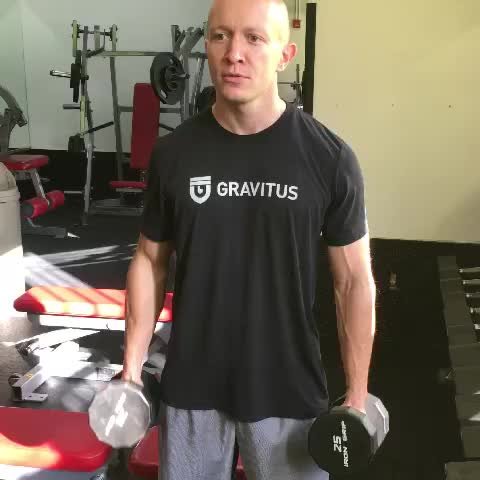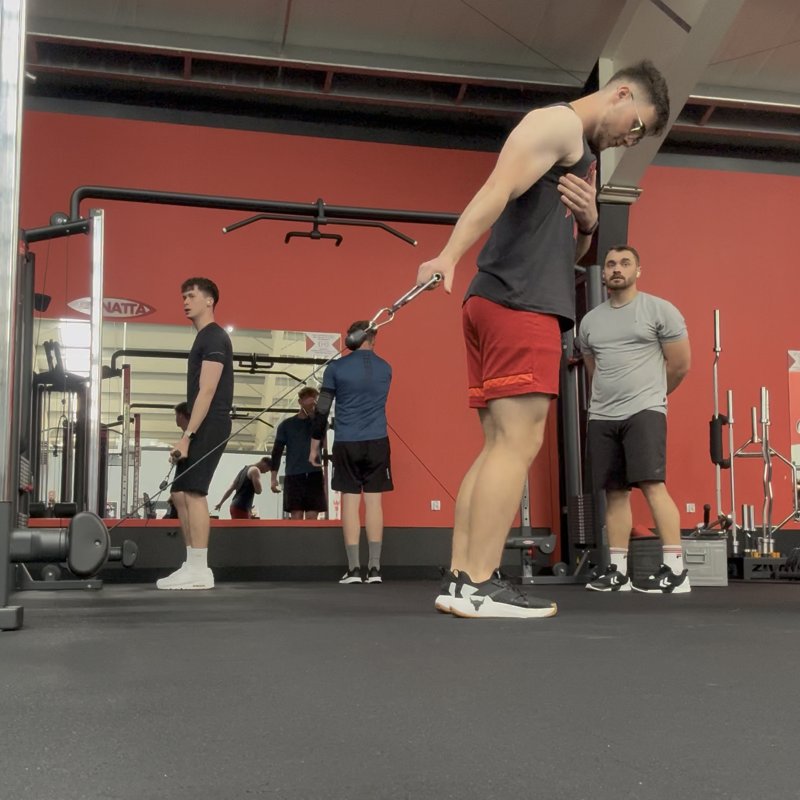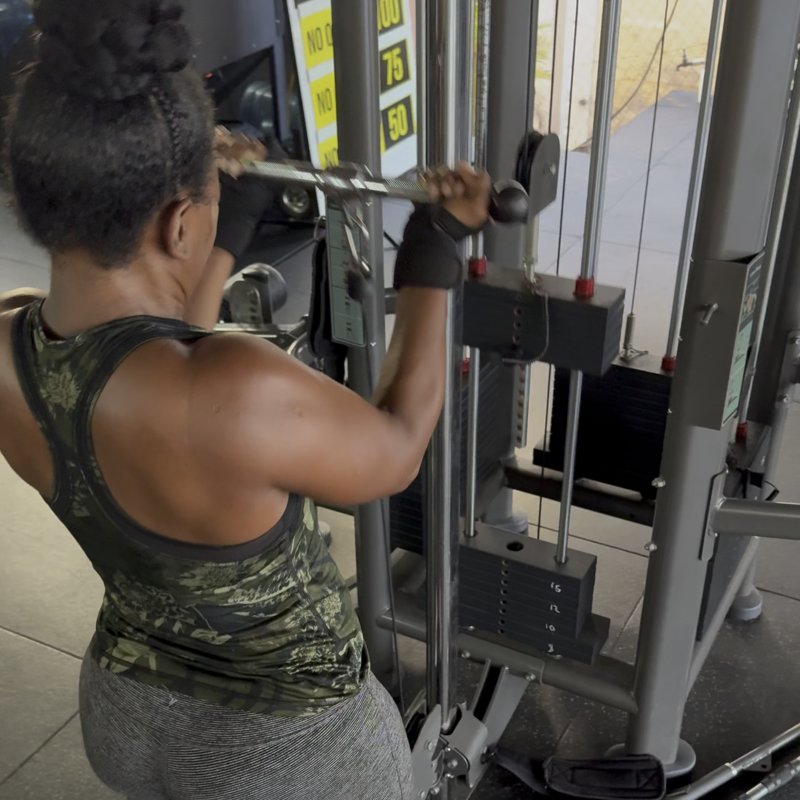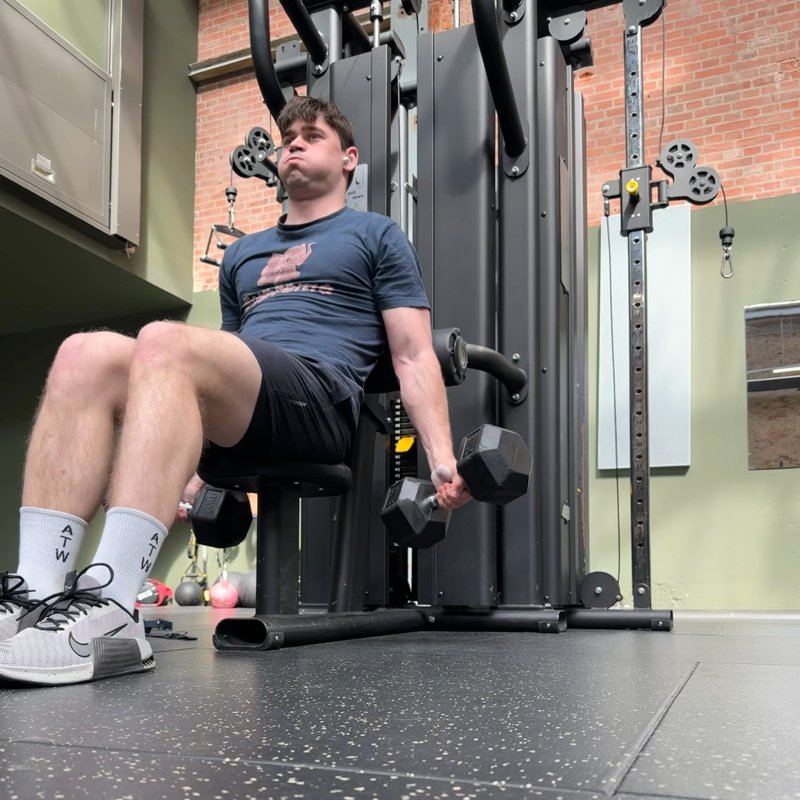Cable Rope Hammer Curl: The Ultimate Guide
The Cable Rope Hammer Curl is a bicep and forearm exercise performed using a rope attachment on a cable machine, targeting the brachialis, brachioradialis, and biceps brachii with a neutral grip position.

Quick Facts
Key Benefit
Balanced bicep and forearm development with constant tension
Primary Muscles
Biceps, Brachialis
Secondary Muscles
Abdominals, Anterior Deltoids, Forearms, Traps
Equipment
cable machine
Difficulty
Beginner
Type
Isolation
In This Guide
Ready to master the Cable Rope Hammer Curl?
Track your progress, see improvements over time, and build strength consistently.
Download GravitusThe Cable Rope Hammer Curl stands as one of the most effective variations of the classic bicep curl, offering unique advantages for arm development through its combination of neutral grip position and constant cable tension. Unlike traditional dumbbell or barbell curls that primarily target the biceps brachii, the hammer grip orientation engages the often-neglected brachialis and brachioradialis muscles, creating more balanced and comprehensive arm development.
What makes the Cable Rope Hammer Curl particularly valuable is how it combines the benefits of the hammer grip position with the constant tension provided by a cable system. While dumbbell hammer curls offer similar muscle recruitment patterns, the cable variation maintains consistent resistance throughout the entire range of motion, potentially enhancing muscle fiber recruitment and growth stimulus.
Additionally, the neutral grip position (palms facing each other) used in hammer curls is generally more joint-friendly than the supinated grip of traditional curls, often making this exercise more comfortable for those with wrist, elbow, or shoulder issues. Whether your goal is to build thicker arms, increase functional strength, or add variety to your arm training, the Cable Rope Hammer Curl deserves a place in your exercise rotation.
Benefits of the Cable Rope Hammer Curl
The Cable Rope Hammer Curl offers several distinct advantages over other bicep variations, contributing to both aesthetic arm development and functional strength.
Balanced Arm Development
Targets the brachialis (which lies underneath the biceps) and brachioradialis (in the forearm) in addition to the biceps brachii, contributing to comprehensive arm thickness and proportion.
Constant Tension
The cable machine provides consistent resistance throughout the entire movement, unlike free weights which have varying tension based on lever arm and gravity.
Joint-Friendly Design
The neutral grip position places less rotational stress on the wrists, elbows, and shoulders compared to supinated grip exercises, potentially reducing discomfort for those with joint issues.
Improved Grip Strength
The rope attachment challenges your grip in ways that solid handles don't, creating additional stimulus for forearm and grip development.
Functional Carryover
The hammer grip position mimics many real-world lifting and carrying actions, potentially improving performance in daily activities and other exercises.
Peak Contraction Enhancement
The ability to slightly separate the rope ends at the top of the movement creates an additional contraction stimulus that's not possible with fixed implements like dumbbells.
Proper Form & Technique
Setup
- Attach a rope handle to a cable machine set at the lowest position.
- Stand facing the cable machine with feet shoulder-width apart, about 1-2 feet away from the pulley.
- Grasp the ends of the rope with a neutral grip (palms facing each other).
- Position your elbows close to your torso and slightly in front of your body.
- Stand tall with chest up, shoulders back, and core engaged.
- Establish a slight forward lean (approximately 5-10 degrees) to optimize arm positioning.
Movement
- Keep your upper arms stationary against your sides throughout the movement.
- Initiate the curl by contracting your biceps and brachialis, not by moving your shoulders or elbows.
- Curl the rope upward in a controlled manner while maintaining a neutral grip position.
- As you approach the top of the movement, focus on contracting your biceps maximally.
- Optionally, at the peak of the contraction, slightly rotate your pinky fingers upward and outward (supination) for enhanced peak contraction.
- Briefly hold and squeeze at the top position for 1-2 seconds.
Return
- Lower the weight in a controlled manner, taking approximately 2-3 seconds for the eccentric phase.
- Maintain tension in your arms—don't let the weight pull your hands down passively.
- Lower until your arms are almost completely straight, maintaining a slight bend in the elbows to keep tension on the biceps.
- Avoid fully relaxing at the bottom position, maintaining muscle engagement throughout.
- Repeat for the desired number of repetitions, focusing on quality muscle contraction rather than quantity.
Key Form Tips
Elbow Position
Keep elbows pinned close to your ribcage throughout the entire movement to prevent shoulder involvement.
Cable Angle
Position yourself so the cable travels in line with your forearms at the midpoint of the curl for optimal resistance.
Wrist Position
Maintain neutral wrists (neither flexed nor extended) to optimize force transfer and reduce strain.
Rope Position
Allow the ends of the rope to separate slightly at the top of the movement for enhanced peak contraction.
Body Stability
Resist the tendency to rock or use momentum—your torso should remain relatively stationary throughout.
Mind-Muscle Connection
Focus on feeling the target muscles work rather than simply moving the weight from point A to point B.
Muscles Worked
Primary Muscles
- brachialis: Located underneath the biceps brachii, this muscle is heavily engaged during neutral-grip curling movements and contributes significantly to overall arm thickness. It's particularly emphasized in hammer curl variations.
- brachioradialis: This prominent forearm muscle runs along the thumb-side of the forearm and is heavily activated during neutral-grip curls, contributing to forearm development and elbow flexion strength.
- biceps: Although not targeted as directly as in supinated-grip curls, both the long and short heads of the biceps still contribute significantly to the movement, particularly if a slight supination is added at the top of the curl.
Secondary Muscles
- forearms: The muscles on the inside of the forearm assist in maintaining grip on the rope and stabilizing the wrist throughout the movement.
- anterior deltoids: The front shoulder muscle provides minor assistance, particularly if strict form isn't maintained. Proper execution minimizes its involvement.
- abdominals: The abdominals and lower back work isometrically to stabilize the torso and prevent excessive movement during the exercise.
- traps: The upper back muscles contribute minimally as stabilizers to maintain shoulder positioning during the curl.
Common Mistakes and How to Fix Them
Using Excessive Body Movement
Swinging the torso to generate momentum reduces muscle activation and increases injury risk. Fix by using a weight that allows strict form, focusing on moving only at the elbow joint. Try performing the exercise with your back against a wall to eliminate swinging, or reduce the weight until you can maintain proper form. Remember that controlled movement with proper mind-muscle connection is more effective than moving heavier weights with poor form.
Allowing Elbows to Drift Forward
When elbows move forward during the curl, tension shifts away from the target muscles and shoulder involvement increases. Keep your elbows pinned to your sides throughout the entire movement. A helpful cue is to imagine holding small objects between your elbows and ribs that you can't drop. If necessary, perform the exercise one arm at a time to enhance awareness of proper positioning.
Excessive Wrist Movement
Flexing or extending the wrists during the curl reduces tension on the target muscles and can cause wrist discomfort. Maintain neutral wrist alignment (in line with your forearms) throughout the movement. Think of your hands as hooks that connect to the rope rather than active participants in the curling motion. Strengthening your grip separately can help maintain proper wrist position during heavier sets.
Incomplete Range of Motion
Not fully extending the arms at the bottom or not curling high enough at the top limits muscle fiber recruitment. Focus on working through a complete range of motion—from a nearly straight arm at the bottom (maintaining slight tension) to a fully contracted position at the top. Use a lighter weight if necessary to achieve the full range without compromising form. Consider doing "21s" (7 bottom-half reps, 7 top-half reps, 7 full reps) to ensure you're developing strength through the entire range.
Rushing the Negative Phase
Letting the weight drop quickly during the lowering phase sacrifices potential muscle stimulus. Control the eccentric (lowering) portion of the exercise, taking 2-3 seconds to return to the starting position. Focus on feeling the muscles work eccentrically rather than just getting through the repetition. This controlled lowering also reduces injury risk and increases time under tension, a key factor for muscle growth.
Standing Too Close or Too Far from the Pulley
Improper positioning changes the resistance curve and can reduce effectiveness. Position yourself so there's tension on the cable throughout the entire movement, typically 1-2 feet away from the pulley. The cable should pull roughly parallel to your forearm at the midpoint of the curl. Experiment slightly with your distance to find the position that creates the most constant tension and best feeling in the target muscles.
Exercise Variations
Grip Variations
-

Reverse Grip Cable Rope Curl
Using a pronated grip (palms facing down) while holding the rope to increase emphasis on the brachioradialis and forearm extensors.
-

Alternating Cable Rope Hammer Curl
Curling one arm at a time in an alternating fashion to increase stabilization demands and allow greater focus on each individual arm.
-

Wide-Grip Cable Rope Hammer Curl
Grasping the rope farther from the center, creating a wider hand position that changes the angle of pull and muscle recruitment pattern.
Position Variations
-
Seated Cable Rope Hammer Curl
Performing the exercise while seated on a bench or stability ball to eliminate lower body involvement and increase isolation.
-

Kneeling Cable Rope Hammer Curl
Executing the movement from a kneeling position to reduce body momentum and increase core stability requirements.
-

High-Pulley Cable Rope Hammer Curl
Using a high pulley position and curling downward, changing the resistance angle and creating unique tension patterns through the range of motion.
-

Incline Bench Cable Rope Hammer Curl
Performing the curl while lying back on an incline bench, which pre-stretches the biceps and emphasizes the lengthened position of the movement.
Intensity Techniques
-

Cable Rope Hammer Curl 21s
Breaking the movement into three 7-rep segments—partial reps in the bottom half, partial reps in the top half, and complete range of motion reps—to increase time under tension.
-

One-and-a-Half Reps
Performing a full rep followed immediately by a half rep (bottom to middle position) before returning to the starting position, increasing time under tension and targeting potential sticking points.
-

Iso-Dynamic Cable Rope Hammer Curl
Incorporating an isometric hold at various positions within the range of motion between dynamic repetitions to enhance muscle fiber recruitment.
-

Drop Set Cable Rope Hammer Curl
Performing a set to near-failure, then immediately reducing the weight by 20-30% and continuing without rest, then potentially dropping again for a triple drop set.
Frequently Asked Questions
The primary difference between Cable Rope Hammer Curls and dumbbell hammer curls lies in the resistance profile and tension characteristics. With dumbbell hammer curls, resistance varies throughout the range of motion due to gravitational factors and changing leverage—being most challenging in the middle portion of the movement and easier at the bottom and top. Cable exercises provide more consistent tension throughout the entire range of motion, potentially increasing overall muscle activation. Additionally, the rope attachment allows for slight separation of the handles at the peak contraction, creating an additional supination component that's not possible with fixed implements like dumbbells. The cable variation also provides continuous tension even at the bottom position, whereas dumbbells allow a brief moment of reduced tension. Both exercises are valuable, with cables typically being superior for constant tension and peak contraction quality, while dumbbells offer greater stabilization requirements and convenience when cables aren't available.
Yes, Cable Rope Hammer Curls are particularly effective for forearm development compared to many other bicep variations. The neutral grip position (palms facing each other) significantly engages the brachioradialis—a prominent muscle on the thumb side of the forearm that contributes substantially to forearm thickness. This muscle receives less targeted work during supinated-grip curls. Additionally, the rope attachment challenges your grip in ways that solid handles don't, providing additional stimulus to the forearm flexors responsible for gripping strength. For even greater forearm emphasis, you can modify the standard technique by focusing on a controlled eccentric phase and minimizing momentum, forcing the forearm muscles to work harder. If forearm development is a primary goal, consider complementing Cable Rope Hammer Curls with dedicated forearm exercises like wrist curls and reverse wrist curls, and implement them 2-3 times weekly within your training program.
For many individuals, particularly those with existing elbow issues like medial epicondylitis (golfer's elbow) or lateral epicondylitis (tennis elbow), Cable Rope Hammer Curls often prove more comfortable than traditional supinated-grip curls. The neutral grip position (palms facing each other) places the forearm and elbow joint in a more mechanically advantageous position that reduces rotational stress on the tendons and joint structures. Additionally, the rope attachment allows for natural wrist alignment rather than forcing a fixed position that might create awkward angles for some individuals. That said, exercise response is highly individual—what feels comfortable for one person may still cause discomfort for another based on their specific condition and biomechanics. If you're dealing with persistent elbow pain, it's best to consult with a physical therapist or sports medicine professional for personalized guidance. For preventative purposes, incorporating a variety of grip positions and curl variations throughout your program helps ensure balanced development and reduces overuse of any particular movement pattern.
The optimal placement of Cable Rope Hammer Curls within your arm workout depends on your specific goals and overall program design. For balanced arm development, consider these strategic approaches. If prioritizing overall bicep/brachialis development, perform Cable Rope Hammer Curls after your main compound pulling movements (like rows or pull-ups) and heavier bicep exercises (like barbell curls), typically in the middle portion of your arm training. Use moderate weights for 3-4 sets of 8-12 repetitions with controlled form. For forearm emphasis, place them earlier in your arm workout when you're less fatigued, allowing heavier loading to maximize brachioradialis development. When focusing on peak contraction quality and metabolic stress, position them later in your workout as a "finisher" exercise, using lighter weights for higher repetitions (12-15+) with techniques like drop sets or supersets. For comprehensive arm development, consider alternating between workouts where hammer curls appear early in the sequence and sessions where they come later, providing different stimulus patterns over time. Most trainees benefit from including some form of hammer curl in 1-2 arm workouts weekly, with the cable variation being particularly effective for constant tension characteristics.
The appropriate weight for Cable Rope Hammer Curls depends on your experience level, current strength, and the specific goal of the exercise within your program. Rather than focusing on an absolute number, select a weight that allows you to maintain proper form while working within your target repetition range, with the final 2-3 repetitions being challenging but completable with good technique. For muscle hypertrophy (growth), weights that allow for 8-12 controlled repetitions typically provide optimal stimulus. If your goal is more endurance-focused, lighter weights for 12-15+ repetitions may be appropriate. For strength emphasis, slightly heavier weights for 6-8 reps can be effective, though hammer curls are generally more suited to moderate rep ranges. When first learning the exercise, err on the lighter side to master the movement pattern before progressively adding weight. Remember that progression should be gradual—adding 2.5-5 pounds once you can consistently perform all prescribed repetitions with perfect form. Many lifters find they can handle approximately 60-70% of the weight they use for standard cable curls when performing the hammer variation due to the different biomechanics involved.
Track your progress with Gravitus
Download Gravitus to log your workouts, track your progress, and join a community of fitness enthusiasts.

Helpful Resources
One Rep Max Calculator
Find your one rep max for any exercise without maximal testing. Essential for developing effective strength training programs.
Calculate 1RMWorkout Programs
Follow structured workout programs created by fitness professionals to maximize your strength and muscle gains.
View Programs




